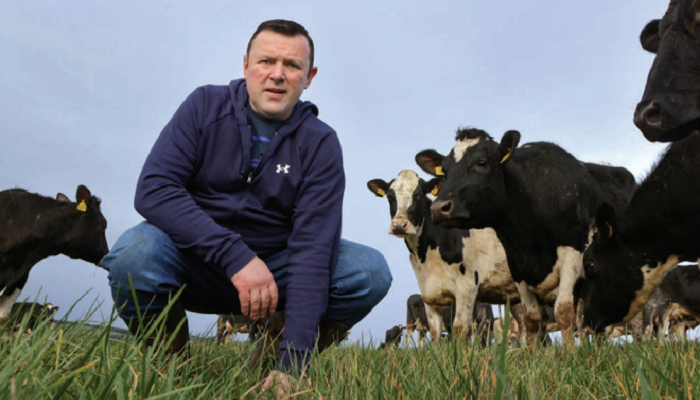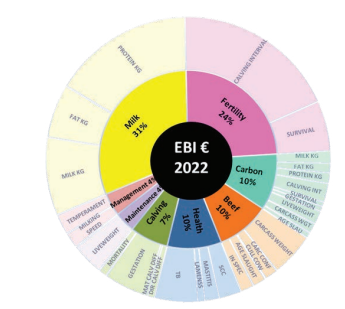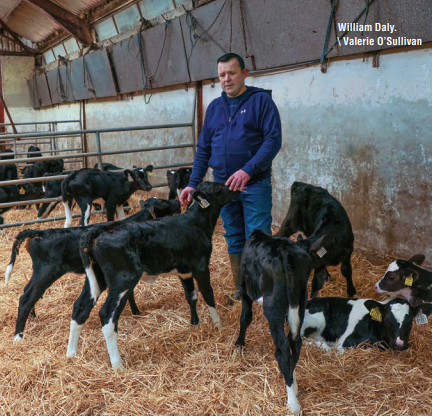26 March 2023
Future-proofing through breeding

The Economic Breeding Index (EBI) has revolutionised dairy breeding in Ireland. It has become the go-to tool when selecting dairy sires. Robert Prendeville, Alan Twomey and Adrian Curtin explain more in this article from the March/April edition of Today’s Farm.
The EBI of dairy females continues to increase by €10 each year, which equates to €2,000 extra profit on farms with 100 cows. To remain relevant, the EBI must adapt to new information, regulations and economic changes. Last November, the EBI got its latest revamp, which saw the addition of a carbon sub-index, an updated beef sub-index, and the inclusion of a TB resistance trait in the health sub-index (Figure 1).
Carbon sub-index
This is the first breeding tool in the world to include the cost of carbon. Although farmers are currently not taxed on carbon, it is envisaged that it could become a cost for farms in the coming years. It will be three years before progeny of sires selected today will be in the milking herd. So including carbon in the breeding index today helps future-proof the industry.
In addition, agriculture must reduce carbon emissions by 25% by 2030 and all farmers will be obliged to assist the sector to reach this goal. The inclusion of the carbon sub-index will speed up genetic progress in reducing the absolute emissions from the dairy herd.
Fertility and maintenance traits have a favourable impact on carbon emissions. For example, a cow with improved fertility will mean fewer replacements are needed and a higher portion of her feed will come from grazed grass, which results in lower carbon emissions. Cows with a lower liveweight will also have lower carbon footprint, as these cows have a lower intake. Nevertheless, cows with higher milk production will have higher total emissions on average, due to the higher feed intake required for the increase in production.
Figure 1: Economic Breeding Index weighting

Beef sub-index
Despite strong markets at the moment, beef coming from the dairy herd is a growing concern due to increasing challenges with exports and long-term profitability on beef farms. Growth in the use of sexed semen is expected, reducing the number of dairy males coming from the dairy herd. However, it is still important to improve, or at least maintain, genetics for beef traits in dairy cows as they will continue to contribute 50% of their offspring’s genes.
The beef sub-index within the EBI was revised, which comprised the inclusion of an age at slaughter trait and an in-spec carcass trait, as well as an update of the economic values for carcass weight and conformation. These updates within the beef sub-index will better reflect the economic cost for beef farmers. This will now cause greater divergence for dairy sires for the beef sub index, which will now penalise the extremely poor beef merit sires more than before.
Breeding advice for the spring
Selecting high-EBI sires is the advice given to dairy farmers in order to continue improving the profitability of their herd. Where possible, sexed semen should be considered, especially for high fertile females, to ensure the number of dairy males is reduced. Dairy farmers will benefit by building relationships with beef farmers and increasing their usage of beef AI.
Beef sires can be selected on the Dairy Beef Index (DBI), which is an index to identify beef bulls that are easy calving and short gestation but also have good beef merit. This will provide a more valuable beef calf for beef farmers and increase the demand for calves in future years.
Case study
Margaret and William Daly are farming in Lismire, Kanturk, Co. Cork. William is also a demonstration farmer on the Kerry and Teagasc Joint Programme.
“We bought the farm in 2013, it was formerly a tillage farm and we converted the land to a grazing platform for the dairy enterprise,” said William. “Cows graze on the home block only. The stocking rate on the farm is 2.48LU/ha. Replacement calves and heifers are contract reared during the grazing months. In 2022, the farm supplied 554kg of milk solids per cow to Kerry.
“We are focused on increasing the milk solids on this farm by utilising grazed grass and increasing herd EBI. Grass covers are recorded on PastureBase Ireland. We put a significant effort into maintaining a high six-week calving rate.”
William purchased sensor technology for the cows in 2021 to further improve herd health and heat detection. In 2022, the six-week calving rate was 82%. The herd EBI has increased from €87 in 2017 to €150 in 2022, an increase of €11 per year. For 2023, the expected EBI of the herd will be €192. The carbon sub-index figure for the herd is €5. Replacement heifers born in 2022 have an EBI of €229. There has always been a strong focus on selecting for protein percentage in particular. Last year, the average protein for the herd was 3.73%.
Coming up to last year’s breeding season, William put a lot of effort into his breeding plan, adding: “Firstly, I wanted to make sure I only generated enough replacement heifers for the herd. I identified cows that I wanted to generate replacements from and the remainder were bred to beef sires.”
For the dairy sires, he was looking for bulls that had a high fertility sub-index (over €100), high fat (over 0.24%) and protein (0.18%) percentages and a good health sub-index (+€3). He used a team of 10 bulls with an average EBI of €292. He also purchased 45 sexed dairy straws for both cows and heifers in an effort to reduce the number of male dairy calves.

William used dairy AI on the intended cows for the first four weeks of breeding and beef AI thereafter. Only high-DBI beef sires were used. A panel of nine beef bulls were selected. Those sires had an average DBI of €85 and ranged from €40 to €119. The gestation length of those beef sires was -1.9 days, with a carcass weight of +7.4kg. Angus and Hereford bulls were used to mop up at the end of the breeding season. After a 13-week breeding season, 8% of the cows were empty in 2022.
“I will have slightly more replacement heifer calves born in 2023 than planned. Approximately 28 replacement heifer calves will be born from the 45 sexed semen straws that were used and a further 15 replacement heifer calves from conventional straws,” he said.
These figures would indicate a replacement rate of approximately 30%. The expected Commercial Beef Value of the beef-sired calves is €122, so they will be good-quality stock for a beef farmer.
“I’m planning on using sexed semen again this year and probably less dairy straws,” William said.
He genotyped replacement heifers born in 2021 and 2022 to ensure the best heifers are selected for breeding. The aim is to have a 25% replacement rate for the farm. The focus on the targets will be similar to last year. The milk sub-index for the team of dairy sires will be over €90, fertility sub-index over €100, maintenance €15, carbon sub-index over €7 and a health sub-index of above €6. However, William will push harder on the fat and protein percentages. He will aim for a team of bulls having fat and protein percentages of 0.3% and 0.2% respectively.
“We will aim to have a DBI team of bulls of €100,” concludes William. “That means everything will be a bit more in balance.”
For more information on Today’s Farm, click here. Photo credit: Valerie O’Sullivan.
